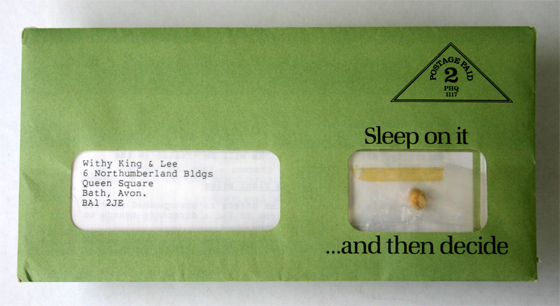Before we get to the point I want to make with this article, let’s look at using a real pea to grab people’s attention.
The image above shows a mailing I wrote back in the early 1980’s. It was for a company that sold company formation services. That’s not a very exciting topic, so we scratched our heads and came up with an idea that would make the mailing stand out.
Our thinking was that most of our client’s prospects were probably fairly happy with the company formation services they already had, but there were probably one or two things about the service that niggled away at them and annoyed them – a bit like the princess trying to sleep with a pea under her mattress.
So that was our starting point.
Yes, that’s a real pea. Yes, we asked a lot from our printer and mailing house: a custom window in the envelope, a real dried pea in a bag, which had to be glued to the letter, and then each mailing had to be hand-inserted.
Expensive, but worthwhile, because we got a response rate of over 17%. (Without the pea it would probably have been closer to 1% or 2%.)
In the world of writing for the web, it’s a little harder to insert a real pea into people’s monitors. But we do need to find some ways to put a pea under the mattress. We need to find a way to make our sales copy hook our readers, and keep them engaged.
There are billions of sales pages online. Most are bad, a few are good. But almost all are simply a rewrite of what everyone else has written. Many follow a formula or a template.
So how can we put a pea under the mattress when we are trying to sell online?
First, get away from the old, offline concept that every sales page has to open with a headline, followed by 500 or 5,000 words of sales text with the occasional sub-head.
Instead of hoping the text will do all the work, why not use a video, slide show, infographic or social media to do the heavy lifting?
No, I’m not talking about those irritating squeeze pages which offer to show a video in return for your contact information. I’m talking about replacing or at least adding to traditional text-based sales pages with multimedia.
You can communicate your value proposition with a video.
You can describe the benefits of your product or service with an infographic.
You can show proof with a slide-show of images, or a second video.
You can replace the usual, barely-credible testimonials with captures of tweets or Facebook updates which praise your product or service.
Or how about communicating your guarantee with a face-to-face video clip?
What I am seeing so far is the occasional use of video and images on sales pages.
What I am suggesting is that you go further, disrupt the traditional sales format, and use multimedia to better capture and engage your readers.
It may not be the same as sticking a pea in an envelope, but it should be enough to separate your sales pages from the billions of others which all seem much the same, and are decidedly old-school and offline in their approach to making sales.

